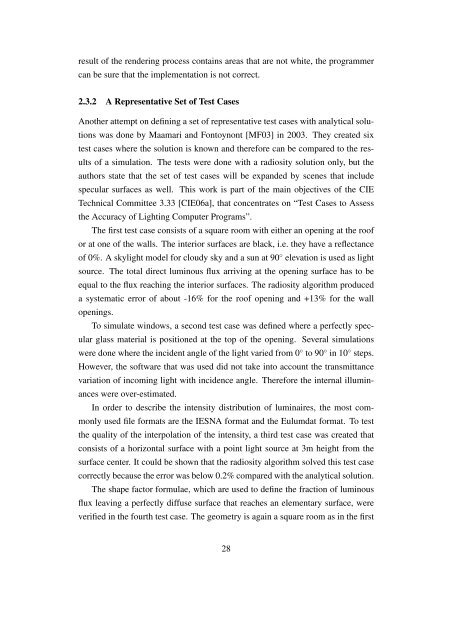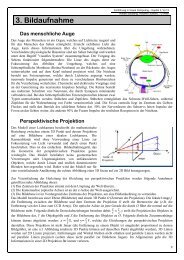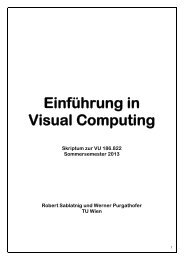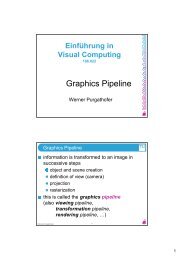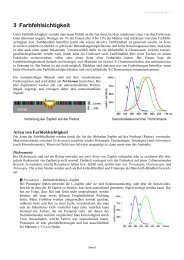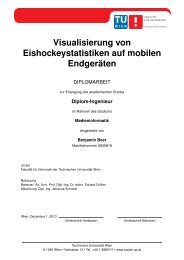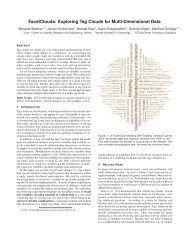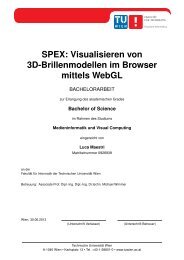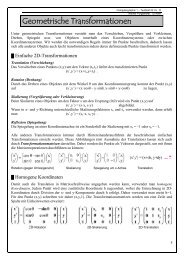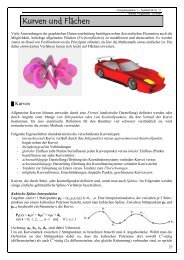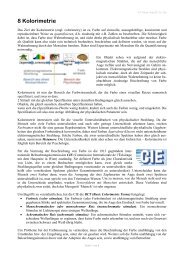Usability of Digital Cameras for Verifying Physically Based ...
Usability of Digital Cameras for Verifying Physically Based ...
Usability of Digital Cameras for Verifying Physically Based ...
You also want an ePaper? Increase the reach of your titles
YUMPU automatically turns print PDFs into web optimized ePapers that Google loves.
esult <strong>of</strong> the rendering process contains areas that are not white, the programmer<br />
can be sure that the implementation is not correct.<br />
2.3.2 A Representative Set <strong>of</strong> Test Cases<br />
Another attempt on defining a set <strong>of</strong> representative test cases with analytical solu-<br />
tions was done by Maamari and Fontoynont [MF03] in 2003. They created six<br />
test cases where the solution is known and there<strong>for</strong>e can be compared to the res-<br />
ults <strong>of</strong> a simulation. The tests were done with a radiosity solution only, but the<br />
authors state that the set <strong>of</strong> test cases will be expanded by scenes that include<br />
specular surfaces as well. This work is part <strong>of</strong> the main objectives <strong>of</strong> the CIE<br />
Technical Committee 3.33 [CIE06a], that concentrates on “Test Cases to Assess<br />
the Accuracy <strong>of</strong> Lighting Computer Programs”.<br />
The first test case consists <strong>of</strong> a square room with either an opening at the ro<strong>of</strong><br />
or at one <strong>of</strong> the walls. The interior surfaces are black, i.e. they have a reflectance<br />
<strong>of</strong> 0%. A skylight model <strong>for</strong> cloudy sky and a sun at 90 ◦ elevation is used as light<br />
source. The total direct luminous flux arriving at the opening surface has to be<br />
equal to the flux reaching the interior surfaces. The radiosity algorithm produced<br />
a systematic error <strong>of</strong> about -16% <strong>for</strong> the ro<strong>of</strong> opening and +13% <strong>for</strong> the wall<br />
openings.<br />
To simulate windows, a second test case was defined where a perfectly spec-<br />
ular glass material is positioned at the top <strong>of</strong> the opening. Several simulations<br />
were done where the incident angle <strong>of</strong> the light varied from 0 ◦ to 90 ◦ in 10 ◦ steps.<br />
However, the s<strong>of</strong>tware that was used did not take into account the transmittance<br />
variation <strong>of</strong> incoming light with incidence angle. There<strong>for</strong>e the internal illumin-<br />
ances were over-estimated.<br />
In order to describe the intensity distribution <strong>of</strong> luminaires, the most com-<br />
monly used file <strong>for</strong>mats are the IESNA <strong>for</strong>mat and the Eulumdat <strong>for</strong>mat. To test<br />
the quality <strong>of</strong> the interpolation <strong>of</strong> the intensity, a third test case was created that<br />
consists <strong>of</strong> a horizontal surface with a point light source at 3m height from the<br />
surface center. It could be shown that the radiosity algorithm solved this test case<br />
correctly because the error was below 0.2% compared with the analytical solution.<br />
The shape factor <strong>for</strong>mulae, which are used to define the fraction <strong>of</strong> luminous<br />
flux leaving a perfectly diffuse surface that reaches an elementary surface, were<br />
verified in the fourth test case. The geometry is again a square room as in the first<br />
28


